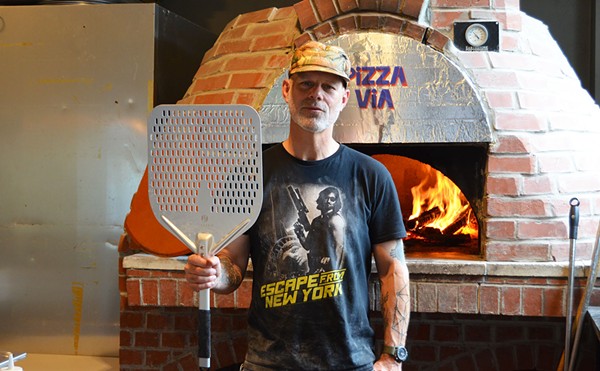Fortunately, the fungal appurtenance -- so useful in a sauce Périgueux, so pointless in a potato -- was not evident in the spud in question. The filling of feather-light whipped potato was so ethereal that the thing was enjoyable in spite of itself, and my blood pressure returned to its usual 150/100.
Babs and I had descended upon the tastefully appointed Truffles for the second time in three days, forgoing our usual Super Tex platters at Nachomama's for a rare WTL (white-tablecloth lunch) in Ladue. After a four-month chefless interlude, Truffles finally has a new chef, and we had come to check the Pesto Index.
Pesto Index, you ask? Well, it's like this:
When Truffles first opened a couple of years ago, pestomania (like the blackened-redfish crisis before it and the "fire-roasted" craze of today) was at its peak. Never before in culinary history had so many basil leaves been plucked by so many rubes to so little avail. Chefs citywide were flinging the stuff around with wild abandon, mutating it in their labs and pestoizing everything from tacos to sorbet, until nary a plate went out without it and this writer had all but acquired a greenish glow. Pesto has its place, sure, but you and I both know that place is not an ostrich pot sticker.
It was in this atmosphere of untempered verdure that I came, somewhat ironically, to regard Truffles as the vanguard of upscale St. Louis dining. Somehow they had managed to vaccinate themselves against the romantic disease of so-called originality, preferring instead to abstain from fads and strike a sane balance between the chic and the sober. I remember I nearly wept when I was served a lobster bisque without a drop of pesto in it. In fact, there was no pesto anywhere near the place. At the time, this seemed positively groundbreaking.
The pesto craze has since receded, but I still use the Pesto Index to gauge a restaurant's faddishness, on the basis of my conviction that innovative does not automatically mean edible. Tony's, for instance, gets a 1. At the other end of the scale is the bizarre Japanese bubble tea, at a solid 10.
So anyway, when I espied good old sole meunière -- a consecrated dish from Saulnier's 1914 Le Répertoire de la Cuisine -- on the Truffles dinner menu, the purist in me turned cartwheels. It turns out that Truffles' new chef of three weeks, Mike Holmes (ex-Lynch St. Bistro, Harry's West, Greenbriar Hills Country Club), continues the noble practice of offering pretty, well-cooked southern European dishes to those brave enough to enjoy food that actually works. Pesto Index = 1.
At lunch, Babs and I discovered everything we'd hoped for in a WTL: the tinkle of iced-tea glasses; the fourtops of ladies-who-lunch; excellent service; and food such as Reuben sandwiches, tuna salad and chicken pot pie. It is the sort of menu that bolsters flagging spirits in troubled times, a welcome respite from all things Enron and Ashcroft. I had a Cobb salad, which contained no trendy surprises and was therefore flawless. Babs ordered prime rib.
Prime rib is the dowdy, decadent lunch of the American dream, recalling brunch buffets at country clubs everywhere, where hung-over guys in two-foot toques, squinting in the orange glint of heat lamps and stoned on Sterno fumes, saw off slabs of bloody beef, douse 'em with jus and shove 'em at bluehairs in church clothes. I cast no aspersions when I say that the Truffles version was refreshingly nonrevisionist. An inch thick, it was rosy in the center, with a forgiving texture and an excellent crust. On the side I found (a) the kind of deliciously over buttered, barely crisp carrots you only see in restaurants where pink-faced captains of industry dine and (b) the aforementioned truffly twice-baked potato.
At dinner a couple of nights earlier, truffle oil was more appropriate and more apparent in the signature dish, a (what else?) truffle risotto. Its refined luxe, combined with lots of Parmesan and a pleasant resistance to the teeth, gave the dish an engaging complexity and made it taste delightfully expensive. Still, mammoth though it was, I might admit to lingering reservations about advocating a $22 plate of rice.
Both of the soups I tried were charming, although neither could be accused of subtlety. I enjoyed a cream of mushroom at lunch. Like any decent mushroom soup, it stimulated a primitive yearning for a walk in the woods. Ultimately, though, its ascension to glory was hindered by what some might consider a heavy hand with the salt shaker, as well as its presentation amid an almost disturbing excess of doilies.
Neither of these flaws afflicted the tomato soup, however. The stuff was larger than life. Augmented liberally with grandiloquent accents of bleu cheese and bacon and served in a stately footed tureen, it made a truly gripping preamble to the second course. Of course, there will be those who may not wish their soup to exhibit more charisma than their date. To them I say, just be glad you're not dating a rock musician.
I waver when ordering veal scallops. The wafer-thin slices of meat often fall prey to chefly malfeasance, shriveling in the sauté pan or morphing into jerky under the salamander. Veal comes (or ought to come, anyway) from calves less than three months old, so it hasn't time to develop much in the way of flavor. Thus the whole point of a scaloppina is its delicate texture. It should melt in the mouth, not in the pan, so a mandible-challenging result is fatal. This is why I made Babs, my trusty food taster, order the veal du jour instead of me. My cunning ploy backfired when the dish turned out to be the Platonic ideal of the classic veal Marsala. The richly nuanced sauce, based on a veal-stock reduction, had been chucked under the chin with the wine and lavished with succulent white mushrooms, and the velvety meat embraced the knife like a long-lost brother. Hallelujah.
I, on the other hand, ended up scowling resentfully at my own selection. This was a mixed seafood grill, served on a bed of risotto with carrots and asparagus. It turned out to be the only stinker of the dozen dishes I sampled. Although the sea scallops were tender and pleasantly smoky from the grill, the stiff, dry shrimp and an unidentified fish steak (tuna? halibut?) were corpses. The risotto, which contained some crunchy fresh asparagus, was a bright spot, but if I'd wanted rice for dinner I would have preferred it unencumbered with anemic marine animals. My suspicion is that this was a fluke and that once Chef Holmes has settled in, such occurrences will be rare.
Aside from this snafu, everything else about the experience made me glad to be alive. Our servers exhibited the kind of gracious poise you'd like to see catch on among car salesmen and gynecologists. The wine list was so gargantuan it nearly sprained my wrist. The gourmands in my party found solace in the sizable portions. Dishes such as flash-fried calamari with a spicy rémoulade, a salad of tomato and homemade mozzarella, and a Belgian-chocolate pâté with crème anglaise were all model representatives of their species. Not to mention the pepper-crusted New York strip: Slathered in one of the nicest things you can slather a steak with -- a sweet onion-and-bourbon sauce -- the dish was spot-on. On the side? A whorl of old-school whipped potato, fluffy as a cloud.





